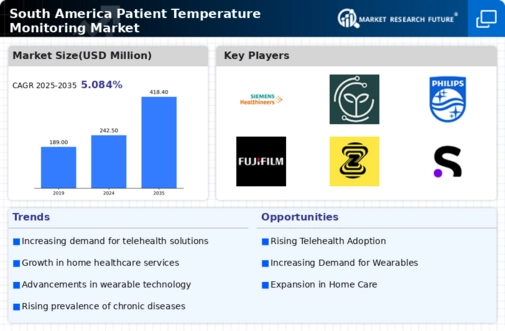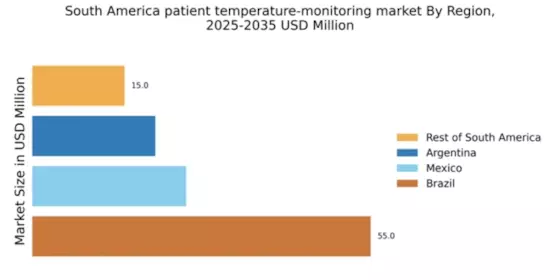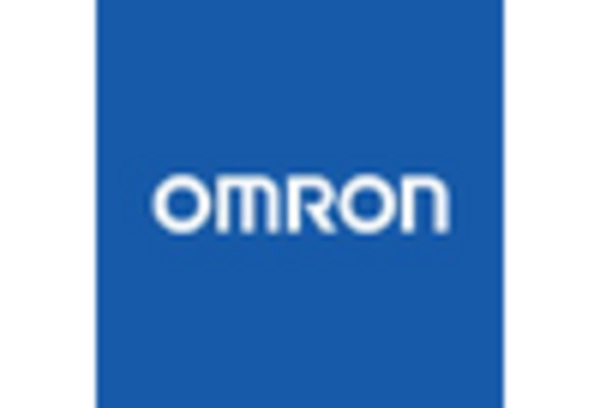Rising Geriatric Population
The increasing geriatric population in South America is a significant driver for the patient temperature-monitoring market. As the population ages, there is a corresponding rise in chronic health conditions that require regular monitoring, including temperature checks. According to recent statistics, the elderly population in South America is expected to grow by over 20% in the next decade. This demographic shift necessitates enhanced healthcare services, including effective temperature monitoring to manage health conditions. Consequently, healthcare providers are likely to invest more in temperature-monitoring technologies to cater to this growing need. The patient temperature-monitoring market is thus poised for growth, as it aligns with the demands of an aging population requiring continuous health management.
Increasing Healthcare Expenditure
The rising healthcare expenditure in South America is a pivotal driver for the patient temperature-monitoring market. Governments and private sectors are investing more in healthcare infrastructure, which includes advanced monitoring systems. For instance, Brazil's healthcare spending has seen an increase of approximately 10% annually, reflecting a growing commitment to improving patient care. This trend is likely to enhance the adoption of temperature-monitoring devices, as healthcare facilities seek to provide better services. Furthermore, as hospitals upgrade their equipment, the demand for innovative temperature-monitoring solutions is expected to rise, thereby propelling market growth. The patient temperature-monitoring market stands to benefit significantly from this increased financial commitment, as it aligns with the broader goal of enhancing patient outcomes and operational efficiency.
Growing Awareness of Patient Safety
There is a notable increase in awareness regarding patient safety across South America, which is driving the patient temperature-monitoring market. Healthcare providers are increasingly recognizing the importance of accurate temperature monitoring in preventing complications and ensuring effective treatment. This heightened awareness is reflected in various initiatives aimed at improving clinical practices. For example, educational campaigns and training programs are being implemented to emphasize the significance of continuous temperature monitoring. As a result, hospitals and clinics are more likely to invest in reliable temperature-monitoring technologies. The patient temperature-monitoring market is thus positioned to expand as healthcare facilities prioritize patient safety and quality of care, potentially leading to a surge in demand for advanced monitoring solutions.
Expansion of Home Healthcare Services
The expansion of home healthcare services in South America is emerging as a crucial driver for the patient temperature-monitoring market. With an increasing number of patients preferring home-based care, there is a growing demand for portable and user-friendly temperature-monitoring devices. This trend is supported by the rising costs of hospital stays and a shift towards more personalized care. Home healthcare services are projected to grow by approximately 12% annually, indicating a robust market potential. As patients seek to manage their health conditions at home, the need for reliable temperature monitoring becomes paramount. The patient temperature-monitoring market is likely to benefit from this trend, as it provides solutions that cater to the needs of home healthcare providers and patients alike.
Technological Integration in Healthcare
The integration of advanced technologies in healthcare is significantly influencing the patient temperature-monitoring market. Innovations such as telemedicine and remote patient monitoring systems are becoming increasingly prevalent in South America. These technologies facilitate real-time temperature tracking, allowing healthcare providers to respond promptly to any abnormalities. The market for remote monitoring devices is projected to grow by approximately 15% annually, indicating a strong shift towards digital health solutions. This trend not only enhances patient care but also streamlines hospital operations. As healthcare systems continue to adopt these technologies, the patient temperature-monitoring market is likely to experience substantial growth, driven by the demand for efficient and effective monitoring solutions.


















Leave a Comment